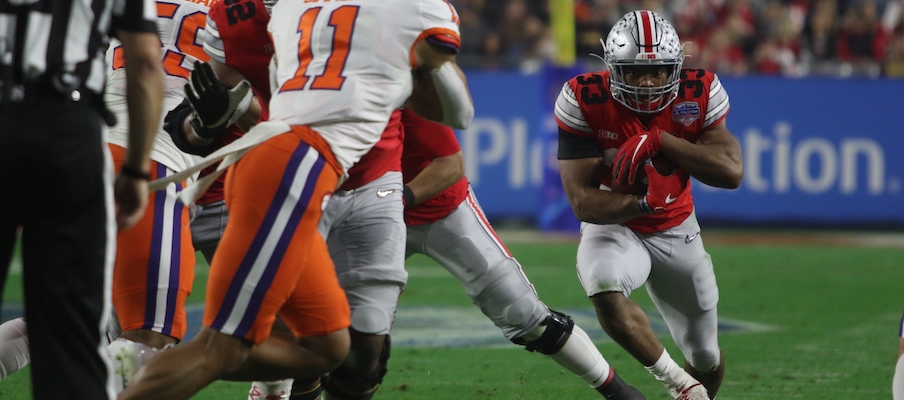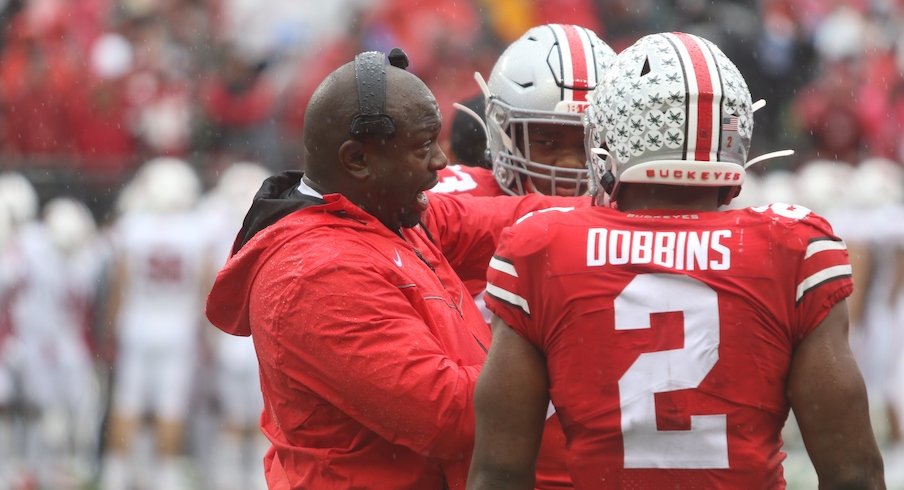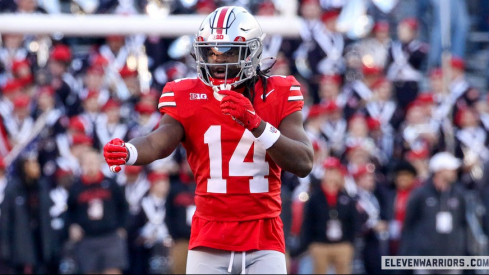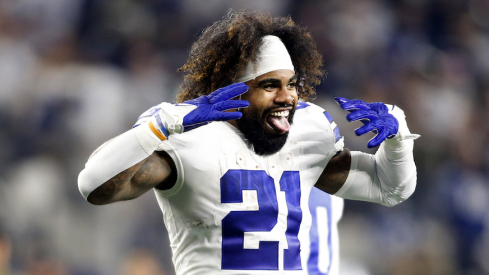Like Babe Ruth in 1932, J.K. Dobbins called his shot.
But instead of standing in the Wrigley Field batter’s box and pointing into the sky to let the pitcher know he was about to hit a home run, Dobbins was talking to reporters on the indoor practice field at the Woody Hayes Athletic Center last spring. In the previous minutes, he had talked about how he “regressed” as a sophomore, saying that even though he rushed for more than 1,000 yards for the second season in a row, he didn’t “take advantage of opportunities” that he did the year before.
Dobbins proceeded to effectively raise his bat and aim it skyward like Ruth.
“I want to be like Ezekiel Elliott and Archie Griffin and guys like that,” Dobbins said in March. “Write my name in stone.”
Dobbins wanted greatness, alerted the world to his goal and then achieved it.
By the end of 2019, he had rushed for more yards in a single season than anybody who had ever donned an Ohio State jersey, reaching 2,003 yards on 301 carries. No former Buckeye, including Elliott and Griffin, had ever cracked the 2,000-yard mark in the history of the program.
Dobbins scored rushing touchdowns in all but one game and ended the season with standout performances against Penn State (36 carries, 157 yards, two touchdowns), Michigan (31 carries, 211 yards, four touchdowns) and Wisconsin (33 carries, 172 yards, one touchdown) before injuring his ankle in the Fiesta Bowl, hampering him as he rushed 18 times for 174 yards and a touchdown versus Clemson.
Dobbins found greatness, and now he’s gone.
Two days after the season ended, he declared for the NFL draft, becoming Ohio State’s only early entrant on the offensive side of the ball. The decision wasn’t remotely surprising; it simply made official what everybody already expected.
As with any standout, there’s no guarantee – even at a program the level of Ohio State – that the next player can reach his predecessor's level, especially immediately. That’s the challenge ahead for running backs coach Tony Alford.
“Obviously in the running back room, those guys will be pretty green,” Ryan Day said on Wednesday. “Master (Teague) played some this year, but we're going to have to replace J.K.”

The search for the future begins with Teague.
The rising redshirt sophomore won the preseason backup running back competition ahead of the 2019 season, making him Ohio State’s second option behind Dobbins. Unlike the Dobbins-Mike Weber pairing the prior two seasons, though, he was the clear backup. Teague only saw occasional carries in moments when the results of games remained in doubt.
His touches typically came late in games, but because the dominance of his team led him to take a boatload of handoffs, he somehow ended up as the seventh-leading rusher in the Big Ten with 135 carries for 789 yards and four touchdowns.
“It's hard with Master because he came into some of those games late in the games and really was a great change-of-pace,” Day said. “He was downhill. He got through it. And he got to the next level and rolled. But what really didn't happen for Master this year is in big moments early in the game, he didn't get a ton of those carries. J.K. got the meat of those carries. So that's the next step for Master is now taking on that responsibility and knowing what he's doing and having some confidence in that because he does have the ability.”
Whether or not Teague can have the success of his predecessors remains to be determined. He showed promise this past season, especially early, but averaged 2.1 yards on 21 carries against Penn State, Michigan and Clemson to end the year.
At 5-foot-11 and 220 pounds, he doesn’t quite have the shiftiness of Dobbins. Instead, Teague is both built like and runs like a muscle-bound bowling ball. He's able to careen through people and pick up speed with a 4.3-second 40-yard dash, but he's not yet adept at cutting away from defenders.
“Just north and south, not a lot of cuts,” said Teague, describing his running style. “I've got speed to run past you, and I can run over you.”
Now the most experienced running back in the room, he’ll get the first chance to prove he deserves a shot at the starting spot.
“I don't know what he has to show us right now,” Day said. “I think that's something we're going to figure out through the spring.”
More than likely, the Buckeyes will turn to a pair or small committee of running backs rather than relying on Teague or anyone to be a sole feature back. There are too many unknowns to think otherwise.
Marcus Crowley and Steele Chambers, rising second-year backs, will spend the spring jockeying for carries, too. They’re a pair of intriguing prospects, but there’s not a ton known about their abilities at the college level since neither got extended playing time as freshmen.
Crowley, Florida’s 2018 Gatorade Player of the Year, had 25 rushes for 237 yards before a late-fall knee injury ended his freshman season prematurely. As the third running back on the depth chart behind Dobbins and Teague, he didn’t redshirt. The 6-foot-1, 205-pound back offers a bit more shift than Teague, which might make them a compelling combination in the backfield.
Chambers rushed 19 times for 135 yards and a touchdown but was limited to four games, taking a redshirt. Added to the team as an athlete capable of playing running back or linebacker, he quickly found a home in the backfield and will factor into the offseason competition.
Even Demario McCall has a chance to earn some carries. Once a top-50 overall recruit from North Ridgeville, a combination of injuries and a lack of a steady position have him still on the outside looking in as he enters his fifth and final season as a Buckeye.
Miyan Williams, a true freshman from Winton Woods, could find himself in the mix, as well. He won’t arrive on campus until June, though, which could put a cap on his immediate output.
“I think we had it nailed down with J.K., what he needed to do,” Day said. “And coach Alford did a great job of that. But that's a young group.”
That young group has the unenviable task of replacing Dobbins, who did what he set out to accomplish, writing his name in stone among the program’s greats.
Dobbins didn’t set the standard of a running back at Ohio State. He reached and continued it, though. When Dobbins called his sophomore season a “failure,” it sounded harsh at the time, but he proved himself correct with a record-setting junior season. At every step in 2019, he offered all Alford could have ever wanted in a running back.
With Dobbins off to the NFL, the Buckeyes don’t have anybody returning with nearly as much past production as him. None of them, except McCall, were even ranked inside the top-200 as recruits either, also unlike Dobbins. That shouldn't allow Ohio State to settle, though. Doing so would be a disservice to itself.
Due to such a high level of recent success, the Buckeyes have to hold themselves to the standard of the Clemsons and Alabamas of college football. Those two teams have Travis Etienne and Najee Harris, respectively, returning to school. Ohio State has a collection of backs who have only been backups, and most of them are underclassmen.
Regardless, Alford and the coaching staff has to pull enough out of Teague, Crowley, Chambers, McCall and Williams to collectively run the ball at the level of the other titans of the sport. With Dobbins, who had already had a pair of 1,000-yard seasons before last year, there was a clear path in 2019 that doesn't exist this offseason.


